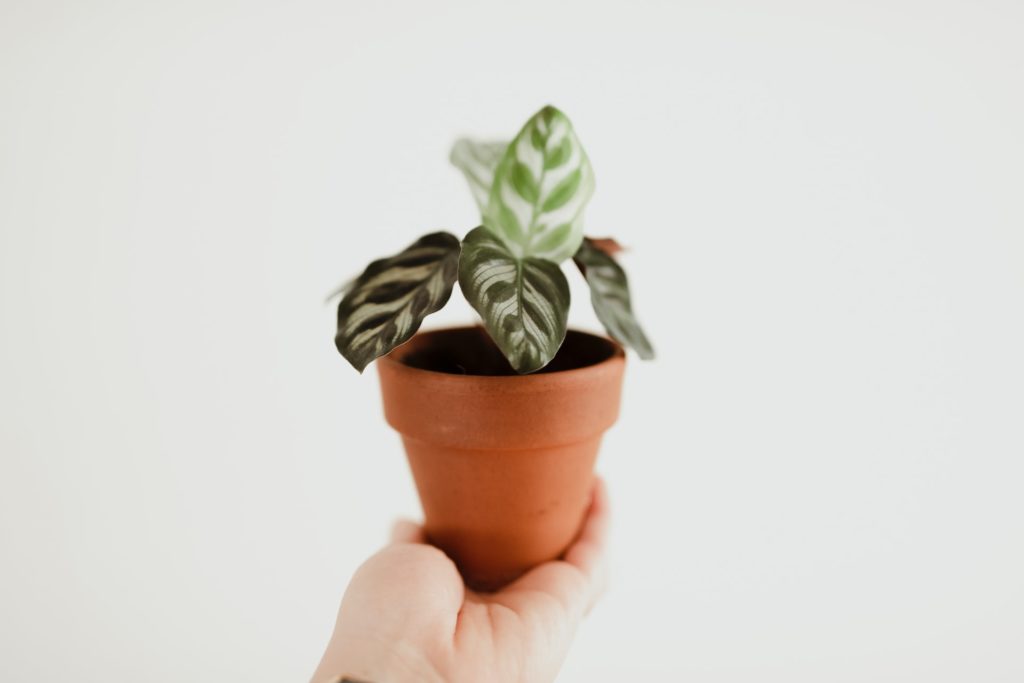Calathea is commonly known as a Rattlesnake plant or prayer plant. The watering habit is the most important factor that determines whether rattlesnake will thrive in your home or not.
In this article, I will discuss how to water your rattlesnake. And the factors that determine the watering frequency. Plus the right water type to use. Also, we will cover how to water Calathea that planted in a pot without drainage holes.
But before diving deep into the details I will put the answer for our main question as simple as this: how to water rattlesnake? Rattlesnake loves moist but not soggy soil. Therefore rattlesnake should be watered only when the top inch of the plant’s soil dries out. And when watered the watering should be deep until the water drains from the drainage holes.
Keep reading to know what determines how often you should water your Calathea.

Factors that determine the rattlesnake watering frequency
For me, I do water my rattlesnake once a week during summer. While I water it every 10 to 14 days during winter. But such a schedule will not work for everyone.
Because the factors that govern the plant’s water consumption vary for each person. The following are the factors that affect rattlesnake water consumption:
Light
A rattlesnake can be placed either on a location that gets medium to low indirect light. In both cases, the plant will be ok.
But when rattlesnake exposed to the medium to bright light it will be more active in its vital process because of the light.
Such a thing will make it consumes more water in order to support such processes. On the other hand, a rattlesnake that located in a low light location will consume less water.
Pot Size
A rattlesnake that planted in a big pot will need less frequent watering. Because the bigger the pot, the more soil will contain. The more soil means more water retention.
On the other hand, a rattlesnake that planted in a smaller pot will need more frequent watering. However, you should always make sure that your plant planted in a suitable planter.
The right pot is the pot that has a length that equals 1/3 of the plant length.
Indoor or outdoor
An indoor rattlesnake will consume less water when compared with the outdoor ones. Because in the outdoor environment the airflow and evaporation rate is higher than the indoor environment.
Season
A rattlesnake will actively grow during the spring and summer. Therefore they will consume more water during those seasons in order to produce more energy to support the growth.
While in winter rattlesnake will go dormant. And it will focus on survival more than growth. Therefore it will need less watering.
As you know now, there is no universal schedule that will work for everyone because the above factors vary from location to another.
Therefore you need more solid rule to how often you should water your rattlesnake plant. In the following section, I will tell you that.
The right way to water rattlesnake plant
Rattlesnake belongs to tropical forests. Where there is high humidity due to the consistent rainfall. Therefore they need a humid environment and moist but not soggy soil.
You can achieve that by placing your plant in a humid environment and water the plant whenever the top inch of its soil is dry. When you water your plant do it deeply until the water drains from the drainage holes.
Also, make sure while you pouring the water to distribute the watering among all the soil surface sides. Don’t pour the water into one spot.
Because such a thing will expose some roots. And it will make some sides dry. The water will not reach the roots that belong to the dry sides.
In such a case the foliage part that connects to those roots may show signs of drought although you watering your plant regularly. Also, water your plant during the morning as it is the best time for watering.
Following this watering rule will work if your planter has enough drainage holes. And you are using a potting mix that retains enough moisture but also drains well.
A potting mix that contains two parts of peat moss and one part of perlite is ideal. Most regular potting mix has such a formula.
The right water type to use
Rattlesnake is very sensitive to the water that it gets. Rainwater is the best water type that you can give to your plant. You can collect rainwater during the fall. Then use it throughout the year.
Also, distilled water will work fine if you don’t have access to rainwater. Tap water is not great when it came to watering your rattlesnake. Because most tap waters contain Fluoride and Chlorine.
And rattlesnake responds negatively to those chemicals. Although tap water contents differ from one state to another. A rattlesnake will have brown leaves edges if it gets those chemicals from the water.
Anyways, If you only have access to tap water leave it in an open container overnight for those chemicals to dissipate in the air before using it. By doing so you will have the best success odds with tap water.
Can I mist my rattlesnake plant?
As I mentioned earlier rattlesnake loves high humidity. They will appreciate regular misting especially if your environment is relatively dry and you don’t have a humidifier.
Signs of overwatered rattlesnake
A rattlesnake that being overwatered will have yellow leaves and a mushy stem. get rid of the affected parts and adjust your watering.
Also, inspect your potting medium. If your potting medium is old ( older than two years) repot your plant in new potting media. Because as the soil ages it loses its drainage properties.
Signs of underwatered rattlesnake
An underwater rattlesnake will have curly and crispy leaves. If this is the case give your plant a good soak of water until the water drains from the drainage holes.
Then empty the saucer in order for your plant to not root rot. And make sure to water your plant whenever the top inch of the soil is dry. While you are practicing this watering habit your plant will recover through time.
How to water rattlesnake that planted in a pot without drainage holes
I don’t recommend planting your rattlesnake in a pot without drainage holes. Because the odds of failure are way higher than the odds of success.
However, some people insist to plant their rattlesnake in a planter without drainage holes for different reasons.
If this is the case your purpose should be to give your plant an amount of water that enough to keep the soil moist without extra water setting in the root zone for a long period of time.
From experience, I found that in order to accomplish such an equation you should give your rattlesnake plant water that equals half of the soil volume.
For example, if the soil fills an X container you should water your plant water that fills half of the X container.
Also, using a more porous potting mix, in this case, can help. Because it will allow the water to evaporate better.
